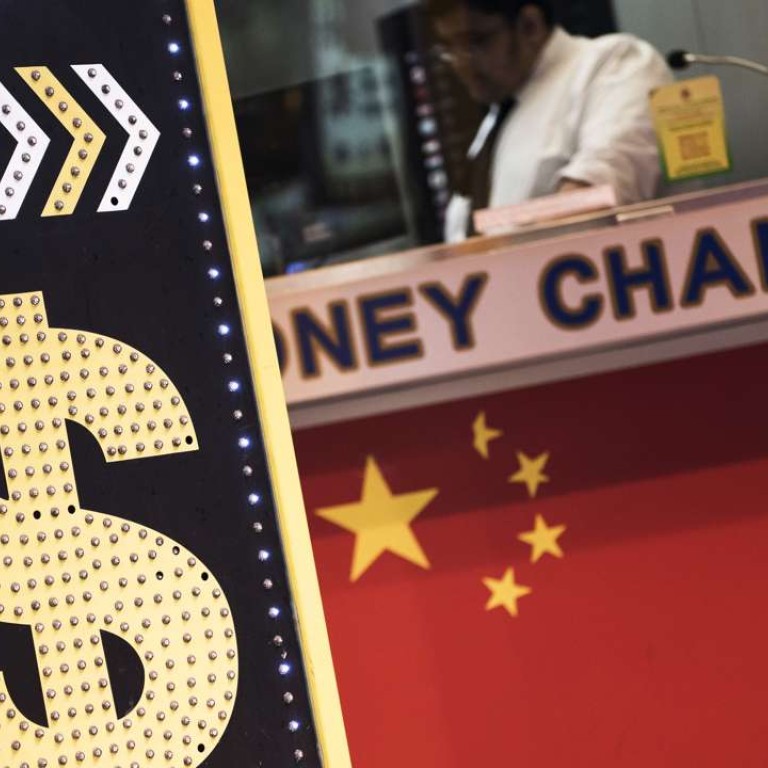
PBOC sets yuan fixing at six-year low amid renewed depreciation pressure
Monday’s action marks the first forex trades in China’s onshore market since the yuan was formally included into the IMF’s special drawing right reserve at the start of October
China’s central bank set the yuan reference rate at the lowest level in more than six years on Monday, in response to renewed depreciation pressure for the currency since the onshore market closed on September 30, ahead of the “golden week” holiday that marks the founding of modern China.
The People’s Bank of China set the yuan reference rate at 6.7008 to the US dollar, 230 basis points or 0.34 per cent weaker than its close on September 30, and its lowest level since September 2010.
Onshore yuan in Shanghai closed the day 0.42 per cent lower shedding 283 basis points at 6.7028 to the US dollar at 4.30pm.
The offshore yuan exchange rate in Hong Kong fell by a similar rate during the mainland holiday. The Hong Kong rate was quoted at 6.7086 on Monday, its lowest levels in six years.
The fixing came after the offshore yuan slid to a nine-month low on Friday amid continuous strength of the US dollar and weakness in the British pound, easing past the 6.7 threshold to 6.7178 against the greenback. Sterling was quoted at US$1.2392 on Monday afternoon, down 0.27 per cent weaker from Friday.
Zhou Xiaochuan, the governor of the People’s Bank of China, said at a meeting of G20 central bank governors and finance ministers in Washington last week that China is trying to seek a balance between exchange rate flexibility and exchange rate stability and will continue to push forward market-oriented exchange rate reform.
Given the continued capital outflows and considering what Zhou said during the G20 meeting, China is expected to increase its tolerance for wider fluctuation of the yuan, said Ming Ming, the chief fixed-income strategist at the Citic Securities in Beijing, in a research note.
Sue Trinh, an analyst at RBC, said a renewed depreciation of the onshore yuan against the greenback was expected after the currency was formally included in the Special Drawing Right basket of International Monetary Fund at the beginning of October, adding there had been early signs last week it would break the threshold.
Wang Youxin, an analyst at Bank of China, said in his latest research note that the movement of the yuan is a retaliatory depreciation, following the government’s intervention to support the currency before its formal inclusion into IMF’s SDR basket.
In mid-September, as a way to fend off short sellers of the yuan, the PBOC is said to have dried up short-term liquidity in the offshore market, pushing up overnight yuan Hibor, the Hong Kong Interbank Offered Rate for the yuan, as high as 23.68 per cent.
Data showing China’s foreign exchange reserves fell in September for the third consecutive month, and at a pace faster than expected, also weighed on yuan, said Alex Wijaya, a senior trader at CMC Markets.
The US dollar continues to show strength, lifted by upbeat economic data, including a recent manufacturing PMI which reached a fresh high for the year. The US dollar index was up 1.1 per cent in the past week.
If the US dollar continues to strengthen, the yuan may decline to around 6.72 to 6.73 against the US dollar, said Liu Dongliang, an analyst at China Merchants Bank.
The latest signs of a weakening Chinese economy are also adding pressure to the yuan.
“Of particular concern is the continued deterioration in key labour market indicators and other indicators which suggests a stalling in China’s economic rebalancing towards the services sector.
“There is a limit to how much China can rely on state support,” Trinh wrote in a note.


